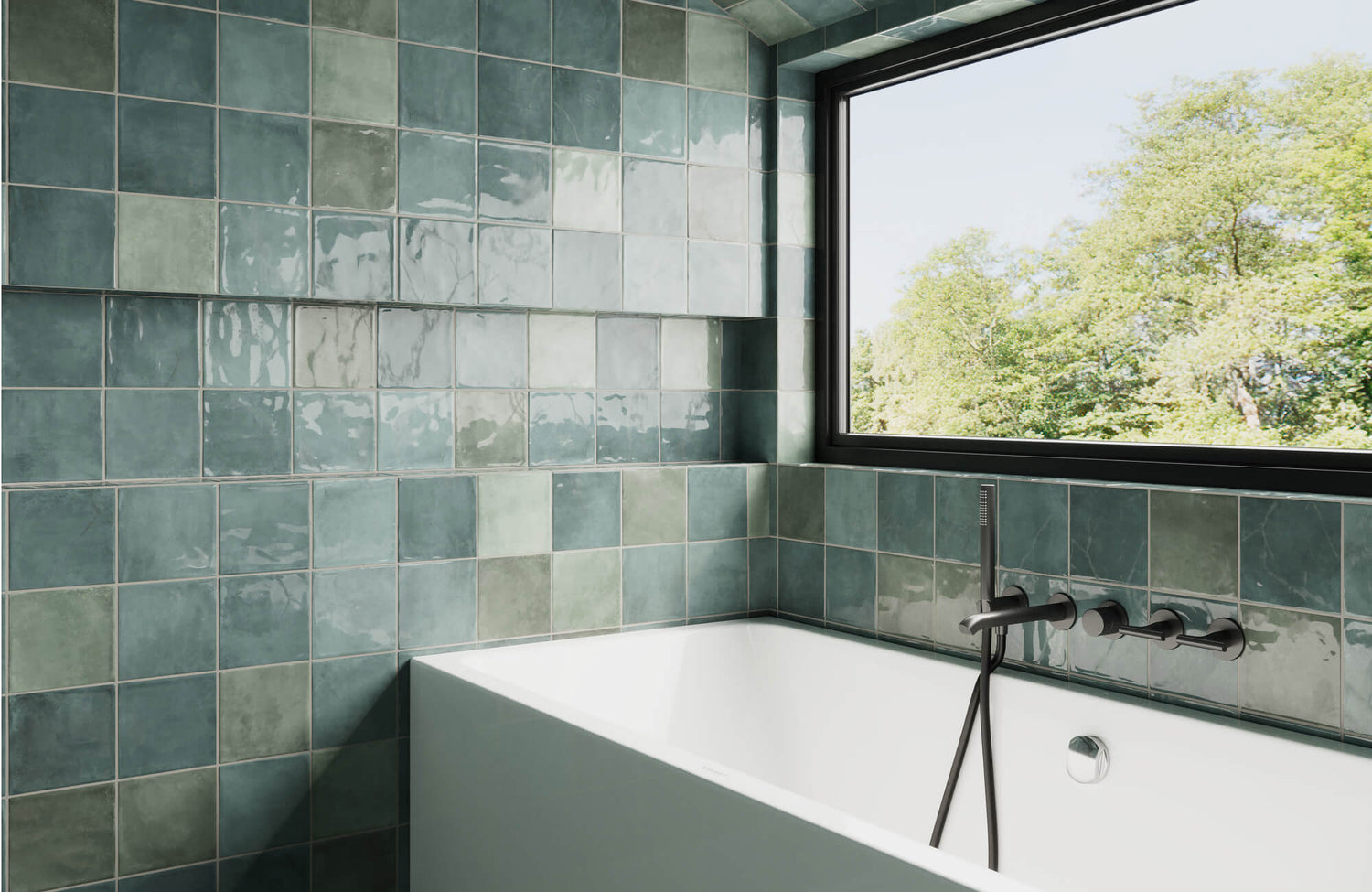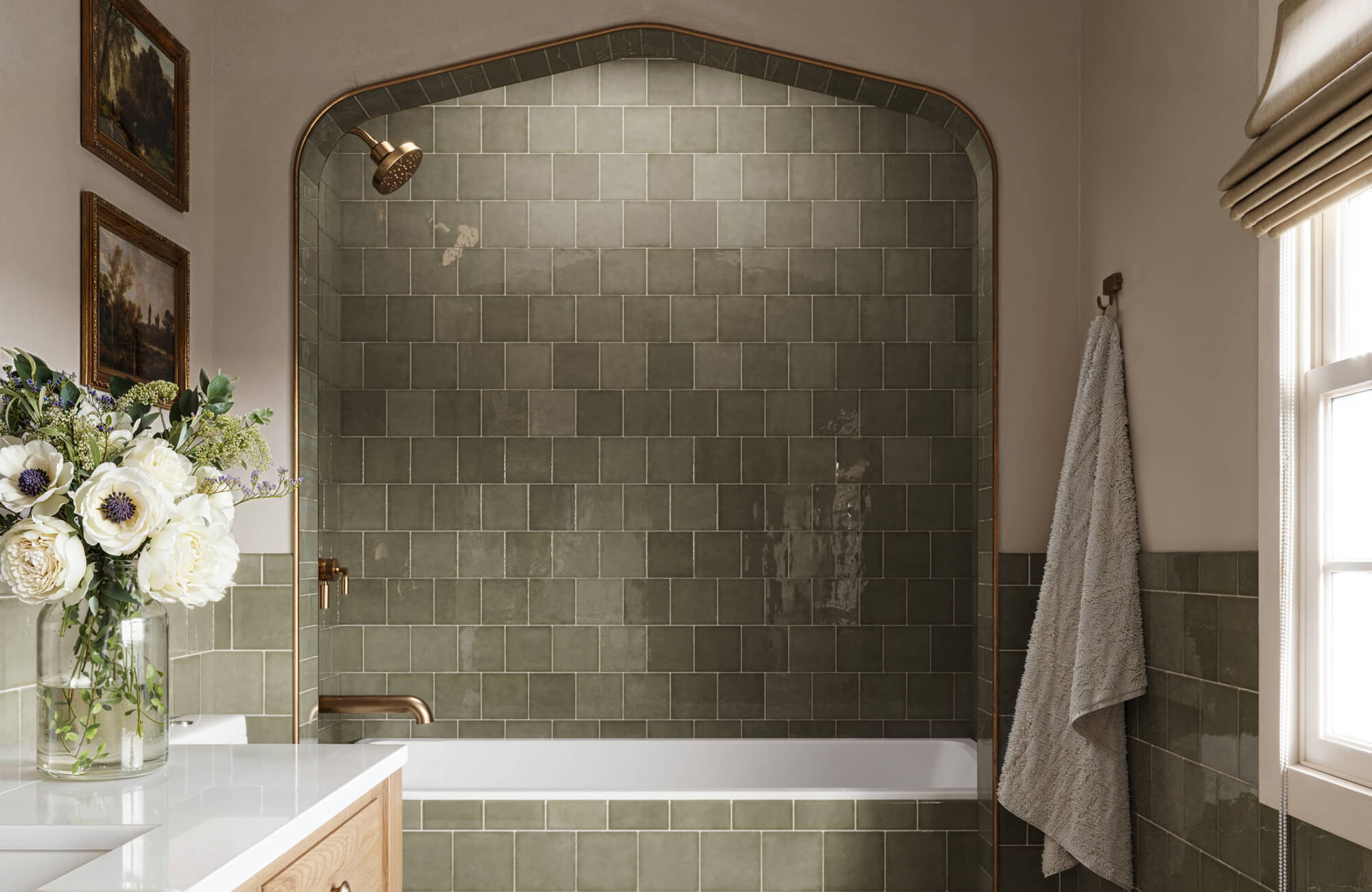Bathroom wall tiles play a pivotal role in defining the style, functionality, and durability of your bathroom. Choosing high-quality tiles, such as those available through our premium tile collections, ensures not only a visually stunning finish but also lasting performance in high-moisture environments. This comprehensive guide will walk you through expert tips to make the best choices for your bathroom wall tiles, so let’s dive into the details.

What to Know Before Choosing Tile Materials
Selecting the right tile materials for your bathroom walls is crucial to achieving a balance between style, functionality, and longevity. By understanding the unique characteristics of different tiles, you can make informed decisions that elevate your space while meeting practical requirements.
Ceramic and Porcelain Wall Tiles
Both ceramic and porcelain tiles are excellent choices for bathroom walls due to their moisture resistance, but they differ in durability and ideal applications. Porcelain tiles are denser and less porous, making them highly durable and suitable for busy areas such as floors.
Ceramic tiles, while slightly less dense, are still highly moisture-resistant and versatile when glazed. They work wonderfully for shower walls, backsplashes, and decorative areas, offering a wide range of patterns, textures, and finishes to complement any design style. While not as robust as porcelain, ceramic tiles are more affordable, making them a practical choice for low-impact applications.
Stone Look & Marble Look Wall Tiles
Natural stone tiles, such as marble or slate, exude luxury and timeless elegance. However, they often require regular maintenance and can be costly. For those who love the appearance of natural stone but want a more practical alternative, stone look and marble look porcelain tiles are excellent choices.
Stone look porcelain tiles, like the Adeline 24x24 Matte Porcelain Tile in Sand, shown in the photo above, replicate the texture and depth of limestone while offering enhanced durability and lower maintenance requirements. These tiles are perfect for achieving a luxurious aesthetic in high-moisture areas, such as showers, without the upkeep associated with natural stone.
Similarly, marble look tiles provide the classic sophistication of marble with the added benefits of affordability, durability, and ease of care. Options such as Edward Martin’s Chantel 3x12 Matte Porcelain Tile in Apuano deliver the veined elegance of real Apuano marble while ensuring long-lasting performance in busy, humid environments.
Both stone look and marble look tiles are available in various finishes and sizes, making them versatile enough to suit any bathroom style. Pairing them with ambient lighting and minimalist fixtures would result in a cohesive design that radiates luxury and modernity.
Balancing Style and Practicality
Whether you prefer the timeless charm of ceramics, the robustness of porcelain, or the luxury of stone-inspired tiles, there is an ideal option for every bathroom. Mosaics with a matte or textured finish are particularly recommended for shower floors, as they provide extra grip and enhance safety in wet conditions. Smaller tiles or those with textured surfaces are better suited for areas prone to moisture, while large, smooth porcelain tiles are perfect for walls and open floors to create a clean and seamless look.
It is always essential to consult with the tile manufacturer or a professional to ensure that the tiles you select are rated for their intended use, particularly in high-moisture or busy areas. This careful consideration will ensure your bathroom design is not only beautiful but also safe and durable for years to come.
Selecting the Best Finish
The finish of your wall tiles plays a crucial role in defining both the appearance and practicality of your bathroom. Glossy wall tiles reflect light beautifully, making them an excellent choice for compact bathrooms or spaces with limited natural light. They create a bright, modern feel and can amplify the sense of space when paired with effective lighting. However, glossy finishes can be more prone to showing water spots or fingerprints, requiring regular cleaning to maintain their shine.
On the other hand, matte wall tiles offer a softer, more understated look, ideal for creating a calm and inviting ambiance. They work well in larger bathrooms or those aiming for a more natural, spa-like feel. Matte finishes are also less likely to show smudges or streaks, making them a practical choice for busy areas. For a balanced approach, consider using glossy wall tiles in areas where you want to emphasize brightness and matte wall tiles in zones where subtle sophistication is preferred.
This thoughtful selection of finishes allows you to create a bathroom that not only looks stunning but also meets your specific design and maintenance needs. To simplify the decision-making process, try using our Augmented Reality (AR) Tool which provides a realistic preview of how your chosen tiles will look in your space. This innovative feature can help you confidently select tiles that align with your style and functional requirements.

Choosing Colors that Match Your Space
The tile colors you choose play a crucial role in setting the mood and functionality of your bathroom. The right shades can dramatically transform the overall look and feel of your space.
Light Wall Tiles for a Spacious Look
Lighter wall tiles, such as white or cream, are perfect for creating a bright, airy atmosphere, and making your bathroom feel more expansive. This effect is particularly valuable in small bathrooms or those with limited natural light. Combining these tiles with mirrors can also amplify the sense of openness, making the room feel larger and more inviting. Edward Martin’s Jaden 2.5x16 Glossy Ceramic Tile in Eggshell, as shown in the photo above, is a great example, offering an elegant solution that can enhance a small space with its reflective qualities.
Dark Wall Tiles for Drama in Larger Spaces
Darker wall tiles, such as navy, charcoal, or emerald, bring a sense of sophistication and intimacy to larger bathrooms. They work well when paired with ample natural or artificial lighting and can be balanced with lighter accessories to prevent the room from feeling too enclosed. When used thoughtfully, these tiles can create a dramatic and luxurious environment.
Combining Light and Dark Wall Tiles Strategically
Using both light and dark wall tiles can create a dynamic and balanced aesthetic. For instance, deep emerald green tiles, such as the Jaden 2.5x16 Glossy Ceramic Tile in Hunter, can be used behind the vanity to create a striking focal point, while lighter tiles on the remaining walls maintain an airy and cohesive feel. This thoughtful combination adds visual depth and enhances the overall design, making the space more engaging without feeling overwhelming.
Optimizing Tile Size and Layout
The tile size and layout significantly impact the overall design and functionality of your bathroom walls. Consider the following:
Large Wall Tiles for a Seamless Design
Large wall tiles minimize grout lines, creating a smooth, uninterrupted surface that enhances the spaciousness of small bathrooms. They are also easier to maintain, requiring less cleaning of grout lines, which can be especially beneficial in busy areas.
Smaller Wall Tiles for Intricate Details
Smaller tiles, such as mosaics, offer opportunities for intricate detailing, making them ideal for accent walls or highlighting niches. Using them sparingly ensures they add charm without overwhelming the overall design.
Mix and Match Tile Sizes Thoughtfully
Combining large tiles with smaller ones in strategic areas, such as mosaics in a shower niche paired with large tiles on surrounding walls, adds depth and keeps the design cohesive. This approach creates visual interest without disrupting the harmony of the space.
Achieving a Functional and Stylish Wall Coverage
Whether to fully tile or partially tile your bathroom walls depends on your design vision and budget. Achieving a cohesive bathroom design involves harmonizing both your wall and floor tiles.
Full-Wall Tiling for a Flawless Look
Fully tiling your walls provides a polished, spa-like ambiance while delivering superior moisture resistance, particularly in high-humidity areas. This option is ideal for bathrooms with a modern or minimalist design ethos. To avoid monotony, incorporate varying textures, patterns, or accent tiles. For example, a feature wall in a contrasting color or texture can break up uniformity and add visual interest without compromising the seamless aesthetic.
Partial Wall Tiling for Budget Flexibility
Partially tiling bathroom walls, especially in splash zones like behind sinks or within showers, allows for a balance between style and budget. This approach works well when paired with waterproof, mold-resistant paint for the untiled areas, offering a practical yet stylish solution. You can also use contrasting or complementary tiles in key areas to enhance the visual appeal of the design while keeping costs manageable.
Matching Wall and Floor Tiles
Using the same tile design for both walls and floors creates a unified, expansive look that enhances simplicity and spaciousness. This approach is particularly effective in minimalist bathrooms or those with neutral color palettes, where continuity can make the space feel open and harmonious.
Contrasting Wall and Floor Tiles
Pairing light wall tiles with darker floor tiles (or vice versa) introduces depth and contrast, creating a balanced and visually engaging bathroom design. For instance, white subway tiles on walls can pair beautifully with slate-look porcelain on the floors for a striking, modern contrast.
Enhance Depth with a Blend of Textures
Incorporating a mix of smooth and textured tiles adds dimension and interest to your bathroom design. For example, you can pair textured porcelain tiles on the floor with glossy ceramic wall tiles in key areas, such as the shower niche or behind the vanity. For shower floors, porcelain mosaics with a matte or textured finish are an excellent choice, as they provide extra grip and enhance safety in wet conditions. Just remember to always consult the tile manufacturer or a professional to ensure the tiles are rated for their intended use and meet bathroom safety standards.
Choosing the Right Grout Color and Thickness
Grout plays a surprisingly significant role in creating a cohesive and polished appearance in your bathroom. Choosing the right color and line thickness for grout can enhance your tiles’ aesthetics and elevate the overall design.
Contrast or Blend: Picking Between Dark and Light Grout
Dark grout defines tile edges with bold contrasts, creating a structured and striking appearance. Light grout, on the other hand, blends seamlessly with lighter tiles, offering a smooth and minimalist look. For example, black grout paired with white subway tiles gives a modern, industrial vibe, while white grout ensures a timeless and clean aesthetic.
Optimal Grout Line Thickness
Thin grout lines complement large tiles, delivering a sleek and contemporary style. Conversely, thicker grout lines highlight textured or handcrafted tiles, emphasizing their intricate details. Aligning grout line thickness across your wall and floor tiles creates visual continuity for a harmonious design.
Creating Your Ideal Bathroom
Bathroom wall tiles are the cornerstone of a functional and stylish space, blending durability and beauty seamlessly. From robust porcelain tiles with smooth finishes to thoughtfully selected accent tiles and cohesive layouts, each choice plays a key role in creating a bathroom that is both practical and visually stunning.
If you’re looking for extra confidence in your selection, explore our 4" x 4" tile samples, crafted to let you see and feel the texture and color of each tile up close. This hands-on approach ensures you make an informed and reliable choice while bringing your design vision to life. When you need personalized guidance, we also offer free design services to give you tailored solutions that guarantee a bathroom that is functional as it is beautiful.











